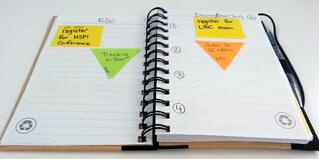Everyone manages their work in different ways. Some people use lists; others prefer to schedule events on their calendars. We can manage tasks through digital mediums or take a more tangible form. My personal task management journey involved many different formats, but always followed the philosophy of personal kanban: visualize work and limit work in progress.

 When I first began my career, I understood the importance of tracking and prioritizing the tasks assigned to me. I liked the idea of keeping a “to-do” list, but felt there was a lack of flexibility when priorities shifted. I kept my first kanban in a small notebook, which I brought with me to meetings so I could record tasks as I received them.
When I first began my career, I understood the importance of tracking and prioritizing the tasks assigned to me. I liked the idea of keeping a “to-do” list, but felt there was a lack of flexibility when priorities shifted. I kept my first kanban in a small notebook, which I brought with me to meetings so I could record tasks as I received them.
I quickly realized that the notes I wrote on were too small to record meaningful tasks. At that time, I also wanted to access my tasks from a mobile device, which I thought would be easier in this digital age. I searched for a program that could help me manage my work using the framework of personal kanban. A number of virtual programs exist, including Trello and LeanKit. Each has merits and faults. I began working with LeanKit because it offered flexibility and robust data analysis tools.
 I used the LeanKit platform for about a year before seeking another way to help visualize my work even more effectively. LeanKit was convenient for keeping my tasks with me at all times, but I often forgot to log in and move a card to the appropriate column as I worked on tasks.
I used the LeanKit platform for about a year before seeking another way to help visualize my work even more effectively. LeanKit was convenient for keeping my tasks with me at all times, but I often forgot to log in and move a card to the appropriate column as I worked on tasks.
A few months later, I saw a video about personal kanban by Jim Benson posted on LinkedIn. This video inspired me to simplify my task management strategy. Jim’s message helped crystalize the goals of personal kanban, which are to visualize tasks and limit work in progress. A whiteboard and sticky notes accomplished this easily, and I no longer need to open a browser window to view current and upcoming tasks.
 My kanban board is at my desk, where I can always see it. If I’m curious about which tasks are coming up, I can just look to my left. If I’m traveling, I’ll take a few notes with me, as a reminder of tasks I need to work on while I’m away. Others can easily see what tasks I’m working on and how their request might fit into my schedule. The “doing” column is intentionally small, forcing me to limit the number of tasks I’m currently working on. This simple board accomplishes the two personal kanban goals Jim describes in his video: visualize work and limit work in progress.
My kanban board is at my desk, where I can always see it. If I’m curious about which tasks are coming up, I can just look to my left. If I’m traveling, I’ll take a few notes with me, as a reminder of tasks I need to work on while I’m away. Others can easily see what tasks I’m working on and how their request might fit into my schedule. The “doing” column is intentionally small, forcing me to limit the number of tasks I’m currently working on. This simple board accomplishes the two personal kanban goals Jim describes in his video: visualize work and limit work in progress.
While this method isn’t perfect, it helps me keep track of my tasks, rearrange them when necessary, and focus only on the most important ones. I’ve found that this simplified method is most effective for me at this moment, but in the spirit of continuous improvement, I’m always open to a new way! Task management is a personal preference that can be accomplished with many different platforms and media. How do you manage your work?

